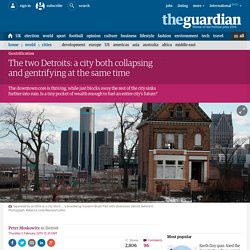Zoom
Trash

MIchael
I like to have fun
The Racist Housing Policy That Made Your Neighborhood - The Atlantic. Before you read this post, read Ta-Nehisi's Coates powerful case for reparations, our cover story this month.

In it, TNC (as he is known around here) relentlessly demonstrates the "compounding moral debts" of discriminatory practices, especially around housing. One of the most heinous of these policies was introduced by the creation of the Federal Housing Administration in 1934, and lasted until 1968. Otherwise celebrated for making homeownership accessible to white people by guaranteeing their loans, the FHA explicitly refused to back loans to black people or even other people who lived near black people. The Threat to Detroit’s Rebound Isn’t Crime or the Economy, It’s the Mortgage Industry. As a young married couple, Steven and Corey Josephson chose to begin their lives together in Detroit.

They came from Greeley, Colorado, a city that couldn’t be more different. It was founded as an experimental utopian community; its majority-white population has more than doubled since 1970; and its unemployment rate is lower than the national average, and about half that of Detroit. But in August 2014, they left. Whites moving to Detroit, city that epitomized white flight. DETROIT — Whites are moving back to the American city that came to epitomize white flight, even as blacks continue to leave for the suburbs and the city’s overall population shrinks.

Detroit is the latest major city to see an influx of whites who may not find the suburbs as alluring as their parents and grandparents did in the last half of the 20th century. Unlike New York, San Francisco and many other cities that have seen the demographic shift, though, it is cheap housing and incentive programs that are partly fueling the regrowth of the Motor City’s white population.
“For any individual who wants to build a company or contribute to the city, Detroit is the perfect place to be,” said Bruce Katz, co-director of the Global Cities Initiative at the Washington-based Brookings Institution. “You can come to Detroit and you can really make a difference.” “A young person can move here with $10,000 and start up a small flex space for artists or artists’ studios,” Seger said.
Elizabeth St. St. Marilyn Salenger: ‘White flight’ and Detroit’s decline. By Marilyn Salenger By Marilyn Salenger July 21, 2013 Marilyn Salenger is president of Strategic Communications Services and a former correspondent and news anchor for several CBS stations.

An almost palpable sadness has swept across the country at the news that the city of Detroit has filed for bankruptcy. While the possibility of this had been discussed, the reality of what was once the fourth-largest city in the United States sinking to such depths is disheartening, a moment people will remember for years to come. To understand that the decline and bankruptcy represent so much more than dollars and cents requires a step back to a time that many would prefer to forget but remains unforgettable. In the late 1960s,racial tensions engulfed parts of our country, at the cost of lost lives and abject destruction.
It was the beginning of the ending we are now seeing for a city that once stood tall with head held high. Opinions Orlando Shooting Updates post_newsletter348 follow-orlando true after3th. 19 shocking facts about Detroit's bankruptcy. Billions in Debt, Detroit Tumbles Into Insolvency. Detroit, Michigan Population 2014, 2015. The two Detroits: a city both collapsing and gentrifying at the same time. James Cadariu was born and bred in a neighbourhood that’s now falling to pieces.

In the late 1980s, Cadariu’s mother and brother were held up at gunpoint in the east side of Detroit. They fled for the suburbs, part of the massive “white flight” that helped turn Detroit from a bustling city of two million into a city of under 700,000. Those who stuck it out became unwilling icons of the supposed decline of the American empire, the subject of a thousand news articles, documentaries and books. Cadariu, now 44, was sick of seeing his city like that. So he came back. “I’ve seen Detroit as a large city. And then there’s the rest of Detroit.
Boomtown and icon of ruinous decline – to say these two Detroits co-exist would be too optimistic. Who Wants to Live in Detroit? - The Atlantic. This article is from the archive of our partner DETROIT—In most cities, the opening of a new Starbucks or chain grocery store is no big deal.

But this is Detroit. "No [chain businesses] wanted to move here. It's all about perception. They thought it was too dangerous," says Jordan Twardy, executive director of the Eight Mile Boulevard Association. Anatomy of Detroit’s Decline - Interactive Feature. Mayor Coleman A. Young of Detroit at an event in 1980. Richard Sheinwald/Associated Press The financial crisis facing Detroit was decades in the making, caused in part by a trail of missteps, suspected corruption and inaction.
Here is a sampling of some city leaders who trimmed too little, too late and, rather than tackling problems head on, hoped that deep-rooted structural problems would turn out to be cyclical downturns. Charles E.